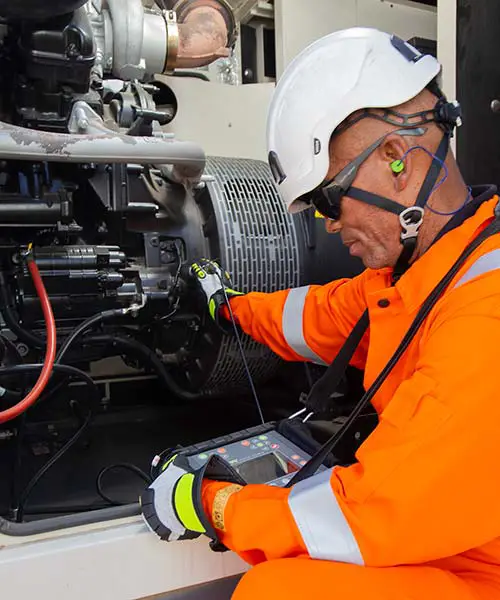Condition Monitoring
Understanding Condition Monitoring – iAdept’s Predictive Reliability Approach
As the name suggests, condition monitoring relates to the monitoring of parameters in machinery or systems as a basis for identifying an existing or developing condition. Just as the human body has symptoms that help a doctor identify fitness, condition monitoring uses machine or system fitness through measurable parameters. As iAdept refers to Condition Monitoring as Predictive Reliability, it introduces planning into your maintenance requirements and schedules.
While most believe condition monitoring is a cost group, we have increasingly proven the profit/return benefits of deploying technology to measure reliability. Predictive Reliability Technologies mitigate major losses owing to unexpected failures or downtimes. With scheduled downtimes, parts inventory, and production losses are a thing of the past. Parts can be ordered when needed, avoiding inventory costs & wastages, production losses vanish, and finally, but most significantly, a failure leading to healthy parts damage ensures equal production losses and the cost of un-utilized salary are totally avoided.
Components of Condition Monitoring are wide spread with diverse applications like body, machine, material, and structural health. Application and usage, and expected output by use of specific technology depend heavily on the expert. Technology decision depends on circumstances, environment, materials, and functional criticality. Hope you see the connection between Condition Monitoring and the Predictive Reliability term coined by iAdept.

Condition Monitoring / Predictive Reliability Technologies:
Understanding Vibrations and iAdept’s Role in Vibration Diagnostics
Vibrations are movement usually identified as shaking around a focal point. As an example seen in the case of a moving part or parts within a machinery or system. Manufacturerus go to great lengths to eliminate vibration as its neither desirable nor good for a machine or system. Vibrations can not only be measured but also understand for reasons and repercussions. Prominent example of Vibrations exist in engines, motors, pumps, turbines etc leading to noise, efficiency losses, parts damage etc.
iAdept has pioneered the Vibration Analysis and Diagnostics field for over two decades not only did we begin with the division in the beginning but also were the first to develop a fully functional and globally competent Diagnostic Software VibAnalyst™.
Acoustic emissions are formation of elastic waves owing to physical changes to material internal structure. The causes of such occurrences could span aging, temperature or mechanical forces including load. Acoustic Emissions are usually detected in frequency range of upto 100 MHz however most of the released energy is within the 1 KHz to 1 MHz Range.
Acoustic Emission help track the problems source, identify machine or material health and efficiency issues as well as mitigate safety risks for example with load or pressure bearing structures like bridges, Buildings and pipeline etc.
iAdept has been utilizing and providing Acoustic Analyzers which with their capabilities support fault and leak detection across industry verticals.
Internal combustion engine incipient fault detection can be carried out without the need of too many sensors. Pressure and TDC (Top Dead Center) analysis vis a vis crank angle, engine situation in terms of pressure, air intake & release etc. Top dead center is of importance, since 1 degree error causes a 10% evaluation error on IMEP leading to a 25% error on heat release at combustion. As a concept Pressure signal Analysis has revolutionized the Marine and DG set condition monitoring and testing requirements.
iAdept introduced a revolutionary product that does away with an iterative methodology of monitoring and analysis. The product used indicator value based Pressure Signal Analysis setup that can be used on large propelling DG sets or backup generators alike.
A popular and widely used technique within condition monitoring is detection of infrared or thermal heat signatures. All objects have a heat signature above the zero degree mark, meaning it is always possible to see your environment even without illumination. Temperature is the most common parameter for machinery as also with humans and animals. An indicator of friction, tension, electrical resistance and drop in cooling efficiency are easy to pin point with a thermal map of the equipment. It has also found use in medical areas of detecting diseases with specialized equipment with abiltity to do so.
From experience thermography works in collaboration with vibrations, ultrasonics or motor current analysis. Thermography is able to isolate the problem area and the collaborative technology helps pin point the issue further.
Aanlysis of lubricants and oils is usually an offline process conducted through a lab analyzing lubricant properties, suspended contamination and wear debris. Part of Industrial Tribology study, Lubricant Aanlysis is usually done via continuous sample analysis monitoring trends over machine life span. A recognized and capable lab and a strict analysis plan for trend identification is all that is needed for Lubricant Analysis and related judgement.

Motor Current Signature Analysis (MCSA)
The origins of the concept can be traced back to the 1970s, when it was initially proposed for use in nuclear power plants for inaccessible motors or those placed in hazard zones. The technique benefits from use within normal working and load conditions without operational interruptions. MCSA is a method from the wider field of Electrical Signature Analysis (ESA) utilized for generators, power transformers & electric equipment beyond electrical induction motors that MCSA deals with.
MCSA detects the following faults:
- Stator Faults (opening or shorting of coils of stator windings) & abnormal windings.
- Bent Shaft, which could be catastrophic owing to friction between rotor and stator.
- Bearing and gearbox faults.
- Broken or cracked rotor bar or end rings.
- Air gap irregularities static and dynamic.
iAdept offers products dealing with Motor Current Signal Analysis. We understand the need to constantly monitor the signals for early detection of faults. We understand the benefits of coupling MCSA as a technique in collaboration with Vibration and Thermography, and encourage simultaneous as well.
The technique utilizes information from current and voltage signals across all three phrases simultaneously. While Motor Current Signal Analysis monitors single stator current thus deploying one of the three phrases of motor supply current and using motor stator windings as transducers, MBVI utilizes all three phrases and establishes a mathematical relation between voltage and current. Applying the model and using measured voltage, a modeled current is created to compare with actual. Deviations thus highlight imperfections in the motor or equipment which can be analyzed using Park’s vector, Fourier analysis & algorithmic assessment of resultant spectrum. These are premanent solutions rather than a short term diagnostic system.
Calibration as a field deals with accuracy measurement and alignment to approved standards of your test and measurement equipment. iAdept has been helping companies improve accuracy of their vibration measurement devices for well over two decades.
Calibration services have been carried out both on-sight and off-sight as the case was. The equipment calibration isn’t only required for audit approvals but is also well established process to ensure efficiency isn’t compromised.

